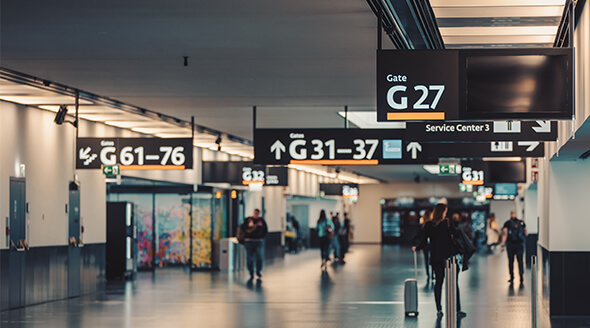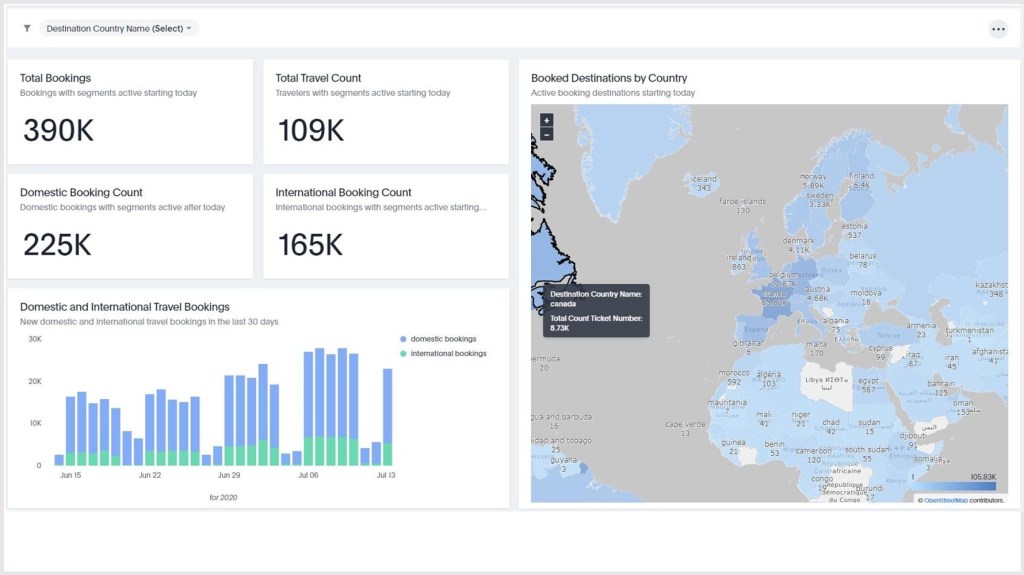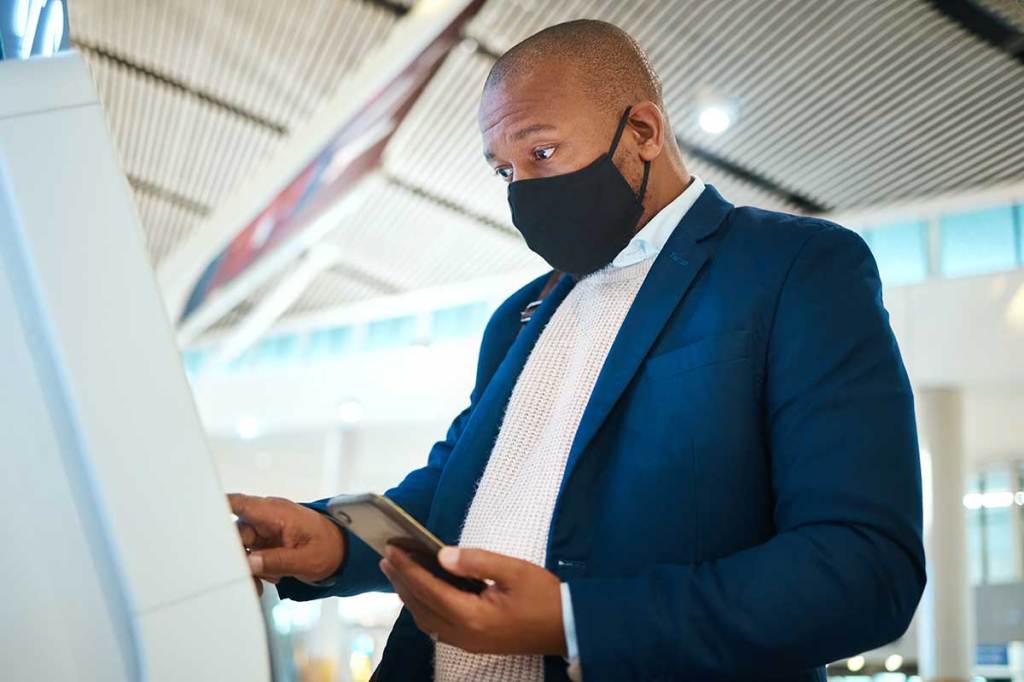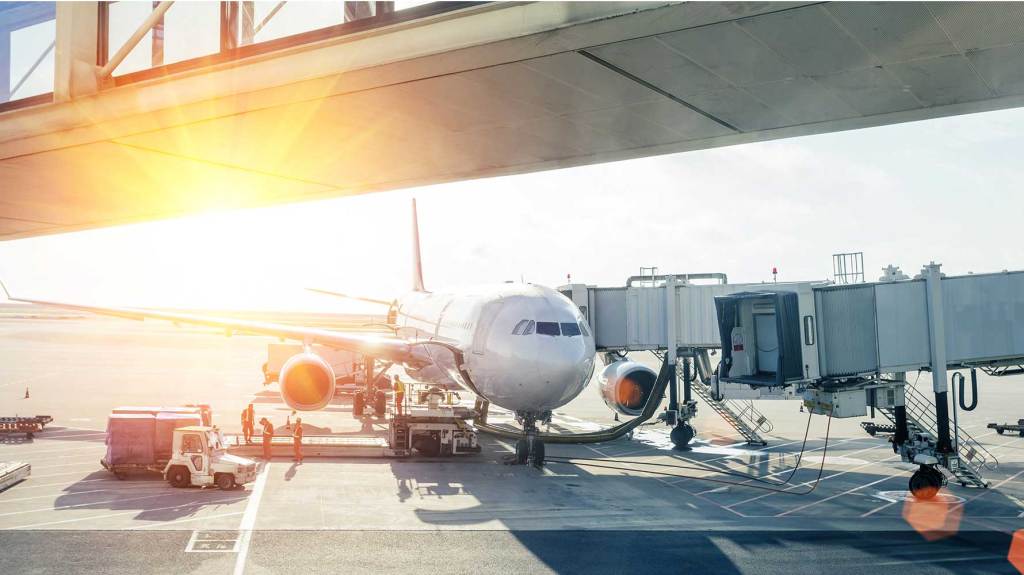Introducing the latest myCWT product and service enhancements
Building on our digital, omnichannel myCWT platform, our new products and services will simplify travel management for you and your employees – anytime, anywhere, anyhow.
Note: Featured services may not be available in your country at this time. Please reach out to your CWT representative for more details.
Hear from Chief Product Officer, Erica Antony as she shares the key product highlights of 2024, along with the key areas driving innovation.
-

2040: Baseline, Boom or Bust
As we enter an era of rapid transformation and unprecedented challenges, it is essential for travel managers, meeting & event planners, and corporate decision-makers to look ahead and frame our current strategic thinking with a clear vision of the future. Business travel and meetings and events (M&E) are poised for significant change over the next decade and a half, driven by a complex interplay of sustainability goals, technological advancements, evolving work models, and geopolitical dynamics.
In this paper to mark the 10th anniversary of our Global Business Travel Forecast, we explore, for the first time, a long-term vision of the future and potential trajectories through three distinct scenarios, each offering insights into how these forces should affect policy-making, budgeting and priorities. By examining these scenarios, we can better understand the diverse possibilities that lie ahead and the strategic imperatives required to thrive in each potential future.
Based on trajectory data analysis and interviews with industry leaders, behaviorists and climate tech founders, this forward-looking approach enables us to anticipate changes, strengthen our strategies, and make informed decisions that align long-term objectives. It is through this lens of foresight and adaptability that we can build resilience, seize opportunities, and navigate the complexities of the future.
We invite you to reflect on the insights presented, and consider how your organization can prepare for the opportunities and challenges that lie ahead. Together we can ensure that travel and meetings remain catalysts for growth, scalability and sustainable practices.
- Scenario development is both an art and a science
- Megatrends Shaping the Future of Business Travel, Meetings and Events
- Sustainability goals the new crux of corporate policy
- Technology Revolutionizes Travel Management
- Modern work models spark new travel patterns
- Changing demographics open doors to new opportunities
- Three Scenarios: Base case, boom and bust
- Future-proofing strategies

-

CWT GBTA Global business travel forecast 2025
When it comes to pricing, global business travel has finally reached an enduring, higher baseline. Prices will continue to rise in 2025, but only moderately, so expect a period of normalized growth.
However, this pricing environment, one of marginal gains and price regularity, is fragile. Global leisure travel has now realized a lot of its pent-up demand, while corporate travel has been resurgent, with 2024 edging at preCovid levels.
There are many factors at play, whether its volatile oil prices, labor costs and constraints, inflationary pressures, and geopolitical factors. As this elevated baseline edges upwards, albeit marginally, travel budgets will come under increased scrutiny, especially as travel patterns and attitudes change.
It’s why business travel can’t be viewed in a silo, and the true value to an organization must be fully realized. This forecast can help with those calculations.

-

Capitalize on emerging technologies in corporate travel
Technological advancements are accelerating at an unprecedented pace. How will emerging innovations like Generative AI, blockchain, and self-sovereign identity (SSI) transform corporate travel?
BTN and CWT probed global CEOs, travel managers, industry consultants and tech experts on the promises, questions, and expectations these innovations raise and how they are set to reshape traveler experience, cost control and service delivery in corporate travel and events.
Download and discover
- The technologies that will have the greatest impact on corporate travel in the next 2-5 years
- How these emerging technologies are poised to control costs, enhance service and security, and boost efficiency
- The critical challenges, opportunities, risks and roadblocks each innovation raises
- What travel managers, buyers and experts anticipate from these innovations

-

Podcast: Return to Travel: What to expect at the airport
Business travelers are on the road again but many are wondering what to expect at each stage of their trip.
What changes can employees expect before they catch a flight as we start to see a return to business travel?CWT’s Julian Walker speaks to Nina Brooks, Director of Security, Facilitation and IT at ACI World, to discuss new measures to boost traveler safety, how employees should prepare for a trip and the steps that airports have made to build traveler confidence.
[buzzsprout episode=’4876223′ player=’true’]
-

Five things to consider when consolidating your travel program
In the first segment of this two-part series, we covered what consolidation means in the context of managed business travel. I also outlined some key benefits of taking a consolidated approach, which is why it’s widely considered a best practice for corporate travel programs.
Still, I like to think of consolidation as a journey rather than a destination. It requires planning and preparation, as well as some fine-tuning along the way.
As you start to lay the groundwork for consolidating your program, here are some important factors to consider:
1. Balance standardization and localization
An important part of consolidating a travel program is to standardize processes and policies across different geographies, as it makes the program more efficient. But while having a globally consistent approach has many advantages, ignoring market-specific nuances can be a big mistake.
For example, having an integrated visa offering may not be a priority for employees in Singapore, but it would be a key priority for local employees in India as they require visas for most of their international travel. Similarly, having a standard tax reclaim process will not work across offices due to different regulations.
Striking the right balance between standardization and localization is key, especially in a region as varied as Asia Pacific.
2. Understand cultural differences
Related to the previous point, you also need to factor in cultural differences – both organizational culture, as well as the diversity in markets.
Corporate culture – which impacts employees’ expectations and behavior – can vary widely between companies, and so an approach that works for one organization may not work for another. For example, trying to enforce stringent pre-trip approval processes in an organization where employees are generally given a lot of autonomy and freedom to take decisions probably won’t be well received.
Similarly, practices that are successful in one country may not translate well somewhere else. In some countries, travelers are very comfortable using self-servicing tools, while in others there is a greater expectation for high-touch service.
These cultural differences will impact how much of a change you can make and how quickly you can implement it. Take inspiration from previous large-scale projects that involved a global effort in your organization, such as the transition to enterprise resource planning (ERP) software or expense partner changes. Be patient and work on charting out the stages of transition depending on each location’s ability and speed to adapt, while being sensitive to the cultural and local norms along the way.
3. Get organizational buy-in
Travel is inherently emotional and personal, so having support across the organization is vital to the program’s success. It’s not just buy-in from the C-suite that is important, but also from other stakeholders like finance, risk management, legal and compliance, HR, administrative assistants and/or travel arrangers, and of course the travelers themselves. Equally important is having an efficient mechanism to collect and action on feedback.
As countries continue to grapple with controlling spread of the virus, in many ways the travel experience will probably be less seamless than it was before the pandemic – at least until a vaccine becomes widely available or a treatment is developed. This makes it more important than ever for companies to focus on the wellbeing of their traveling employees and find opportunities to simplify the travel experience where possible.
4. Review your technological capabilities
In some countries, online booking tools may not be common, and the types of services provided typically comprise traditional booking methods with high-touch service. Different countries may also have their own preferred global distribution systems, and are subject to differing airline rules, regulatory limitations and fare filing mechanisms. Employee preferences also play a big role – in China for example, employees prefer using mobile devices to complete their tasks while those in Japan prefer using their desktops.
Gain an understanding of where the levels of technology are in each of your markets. Find out how many systems or programs are being used to ensure the smooth operations of each market, and then work out the process of aligning these technologies across all your locations, so you can improve the overall workflow and easily retrieve information from a central system. Most importantly, remember to ensure that robust data protection measures are put in place to keep all your information secure.
5. Visualize and align on what success looks like
Having a clear and aligned view of success will help you prioritize the non-negotiables and keep you focused. Develop a clear timeline and have a list of short- and long-term KPIs to keep you on track.
Discuss with your major stakeholders and develop a list of requirements when consolidating your travel program, such as duty of care, employee wellbeing, cost savings, policy compliance and sustainability.
There’s no doubt that consolidating a travel program can be a complex endeavor, and perhaps the biggest mistake I’ve seen companies make is to underestimate the preparation that’s required. If you do your research, gain deep insights into your organization, and work with an experienced partner who can help you draw up a roadmap and guide you on how to implement these changes, you will set yourself up for success – and the results will be worth it. You will create a better travel experience for your employees while simultaneously improving efficiencies and saving money.
This article was first published on TTGmice and is republished with permission.
Image credits: Adobe Stock
-

How to turn travel trepidation into creative rocket fuel
As many countries emerge out of lockdown, business travel is beginning to resume. It should come as no surprise. An Oxford Economics study found that each dollar invested in business travel can result in as much as $12.50 in revenue. Another recent survey by consulting firm Oliver Wyman found that nearly 60% of business travelers expect to travel the same amount or even more after the pandemic, due to a resurgence of business activity.
Now more than ever, we know the emotional value of face-to-face interactions and the connections and inspiration that we previously took for granted.
Still, most travelers fall into one of two camps. There are those who after months of spending their days within their four walls are aching to jet to the other side of the world. Like a beach ball submerged under water and suddenly released, they’re ready to race to an airport and would hug everyone along the way if physical distancing wasn’t still in place. And there are those who feel trepidation, regardless of the measures, cleaning protocols and frameworks now in place.
We all know the longterm value of a well-planned business trip but it’s wasted if you’re constantly fretting along the way. Here are three ways to approach your first trip out of lockdown, mitigating concerns and leaving you free to do what’s best for your career and organization, creatively and enjoyably.
- Seize the opportunity to visit somewhere different
Embrace the chance to replenish your reserves of creativity after months of the same scenery. Plan for a little leisure time, ranging from a boat tour (you’ll be supporting the local economy) to a leisurely al fresco tasting menu at a cool restaurant that could do with your custom.
The idea is to disconnect from the stresses of business travel, really switch off, and explore a new destination. - Stick to the facts
Being informed helps us make clear decisions. But there’s staying-up-to-date and there’s doom scrolling.
A global event mired in uncertainty can make the most disciplined among us hooked on an endless scroll of media that’s amplified, leveraged, and optimized to suck us into a Covid-hole for hours on end. And fear sells more than stories of progress.
If it’s not helping you make informed decisions, what’s it for? Stick to a maximum of two or three trusted resources and limit your time on them each day.
Check your travel restrictions with a few clicks using CWT Travel Essentials. - Feel prepared
Work through your travel plans compartmentalizing them into before, during, and after your trip. You’ll know what to pack, what to expect at each stage, and what to do when you get home. It’s much less daunting to follow a simple checklist than to cobble together disparate advice.
By controlling the controllable, cutting out the noise and focusing on the numerous benefits, you’ll be equipped to inspire passion, generate great ideas, and get the most out of a long-awaited business trip.
Image credits: Adobe Stock
- Seize the opportunity to visit somewhere different
-

How ‘work from home’ can increase your corporate IQ
Back in the 1950s, the concept of ‘telecommuting’ was first touted as being the future of work. The term was said to have been coined by Jack Niles, a former NASA engineer who proposed it as an innovative answer to traffic, urban sprawl, and scarcity of non-renewable resources. The concept is still around, but in 2020, we all know it simply as ‘working from home’, or just ‘WFH’.
Covid-19 ushered in the biggest ever jump in WFH. Offices around the world closed down, video conferencing companies saw their subscriber numbers skyrocket and cloud companies rejoiced.
WFH is in the news again this week. As some governments are encouraging a return to working in offices while giving businesses discretion, companies are weighing up the pros and cons.
There are many learnings from 2020’s globally-enforced WFH directive, but I believe the biggest takeaway is that companies can operate and even thrive with their employees working remotely. One recent study by Stanford University found that home-workers in China did 13.5% more work than those in the office – nearly a whole extra day’s work each week. Telecommuting has finally arrived.
By dropping the idea of teams being based in a company building, and embracing a ‘Work from Home’ culture, companies are presented with opportunities that go beyond saving corporate square metres of prime real-estate. Here are 3 ways that WFH can boost your corporate IQ.
- Access to a wider talent pool – With a remote workforce, a company can employ people from literally anywhere and attract the best candidates, without restricting the talent pool to a radius of the office.
How many people have turned down jobs based purely on location, or relocated to an area with unaffordable housing to secure a role? Why do either of these things? Most of us have the equipment and internet connection to do our work from anywhere in the world. Remote working means that a business can be scalable as there is no longer an overhead of ever-increasing office space.
WFH generates potential for a different way to look at recruitment at the point when companies are ready to grow. - Limitless potential – WFH creates additional opportunities when combined with flexible working. Just think of the number of qualified, skilled and talented individuals who are unavailable due to childcare commitments or looking after vulnerable relatives. Many of these people are not reaching their true potential and are currently in roles that provide little job satisfaction.
The WFH culture opens the office door to everyone! - More productive business trips – A distributed work force will increase the need for business travel. It is vital to maintain human interaction with regular training, team bonding and team off-sites. The good news is that there should be a budget for these activities with the savings in office space.
There is also an opportunity to be more strategic with the locations of team meetings. Why not consider taking it in turns to have team meetings in the home towns (or countries) of the team members and involve that team member in the planning of evening activities?
Image credits: Adobe Stock
- Access to a wider talent pool – With a remote workforce, a company can employ people from literally anywhere and attract the best candidates, without restricting the talent pool to a radius of the office.
-

CWT introduces new data-powered solutions to guide companies and traveling employees on resuming travel
CWT, the business-to-business-for-employees (B2B4E) travel management platform, today announces two new additions to its return to travel resources, which will further arm companies and their traveling employees with the information they need to make confident decisions in the rapidly evolving travel landscape:
- Return to Travel dashboards:accessible to CWT clients in all markets, the dashboards amalgamate comprehensive global destination information to help travel managers assess risks and restrictions ahead of, during, and after business trips. The dashboard presents a unique combination of general Covid-19 related information alongside client-specific travel and location detail, giving travel managers the context required to effectively drive their travel programs.
- CWT Travel Essentials search: provides information on applicable restrictions, procedures and travel requirements based on specific travel itinerary details such as trip origin, destination, travel dates and traveler nationality. With rapidly changing circumstances across countries and an organization’s health and safety parameters, this helps business travelers and arrangers to make more informed and timely decisions. The tool is available on a publicly accessible page on the company’s website (mycwt.com) and via the myCWT mobile and web channels
“Central to CWT’s commitment to simplifying travel, these services augment the rich content we already provide customers and their employees, making it easier to assimilate their own risk and restrictions,” said Erica Antony, CWT’s Chief Product Officer. “Our new dashboards and search capability provide travel managers and travelers with curated information that is relevant to their individual programs and travel itineraries. We will continue to add to our resources to help support the wellbeing of our clients throughout the pandemic, and as they return to travel.”
CWT’s return to travel information services are consolidated from multiple third-party sources including government and health advisory sites, travel providers, and universities, to help keep companies and their traveling employees connected to timely and relevant information. The information is aggregated using API connections, enabled by CWT’s innovative partnership strategy with key data and travel technology providers.
CWT is a leading global partner in business travel, meetings, and events. Operating across six continents, we deliver sustainable, tailored solutions that help organizations connect, engage, and thrive in an evolving world. Our myCWT platform integrates advanced technology with human expertise to simplify travel and enhance traveler and attendee experiences. Extensive global coverage, seamless data integration, AI-driven analytics, and carbon-conscious travel tools enable businesses to optimize their travel and meetings programs while delivering measurable value.
With 150 years of industry experience and a deep commitment to partnership, CWT collaborates with clients to shape the future of business travel and events, making them more efficient, responsible, and impactful.
-

5 ways your next hotel stay might be different
As hotels gradually reopen their doors to guests around the world, we can expect some big changes to the guest experience. For one, health and safety measures have taken top priority, with many hoteliers launching new initiatives to step up their hygiene game and ready themselves for when it’s safe to travel again.
Hotel chains with more marketing resources have created new hotel cleaning policies and promoted them actively on their website, membership databases and or through various press announcements. Independent hotels may not have the same marketing resources, but many are taking a cue from the bigger chains, as well as following any existing local regulations, to be able to open their properties to the public.
While cleanliness has long been a key part of hotels’ value proposition, some are taking it to the next level by engaging experts in the health and hygiene industry to develop policies and use products in line with the highest industry standards.
Hilton, for example, has partnered with RB (the company that makes Lysol and Dettol) and the Mayo Clinic to launch the ‘Hilton CleanStay’ program to elevate its cleaning and disinfection protocols. Similarly, the Radisson Hotel Group is collaborating with SGS, a leading inspection, verification, testing, and certification company, to audit its properties and award those that comply with protocols with an official label of cleanliness and disinfection.
With hotels making great strides to create a safer experience and inspire confidence among their guests as travel resumes, here are five ways your next hotel stay could look different:
- New standards of hygiene for rooms
Guest rooms are set to become cleaner. Many hotels have introduced deep cleaning as a mandatory routine for each time a guest checks out. As an extra measure, the ‘Hilton CleanStay’ program also includes placing a room seal on the door as an indication that the room has not been accessed after it was thoroughly cleaned.
To reduce the risk of spread via objects or surfaces, some hotels have chosen to lock or remove their minibars, and take away paper amenities such as pen, paper, directories or room service menus, which will be provided digitally or on request. - Contactless stay
The pandemic has greatly accelerated the adoption of digital room keys, desk-free check-ins and contactless payment solutions in hotels. Aside from reducing the risk of spread in each property, the adoption of these digital solutions will allow guests to manage their entire stays on their mobile devices.
The World of Hyatt application for example, allows guests to book and modify their reservations, check in and out, and view their room charges on the go. Guests can also unlock their rooms and make service requests on the same platform. - Cleaner and quieter public spaces
In line with safe-distancing policies from local authorities, hotels chains like Marriott International have also made conscious efforts to identify high traffic areas and conduct more frequent deep cleaning of public areas using disinfection technologies such as electrostatic sprayers or ultraviolet lights. Pools, spas and gym facilities will also have more scheduled closures for regular cleaning, and possibly a limit on the number of guests allowed at one time. - Food safety
Instead of the usual buffet lineup, expect to see more made-to-order and grab-and-go options for the time being. Furniture could also be reduced or moved around to align with safe-distancing measures, and aside from wearing masks and gloves, staff are being trained to follow enhanced operational and safety procedures when serving guests.
Should guests prefer to dine in their rooms, hotels like Hyatt have in place knock-and-go services, where staff will deliver room service orders to the door and notify guests by ringing their doorbell or knocking. - Sanitizing kits and protective equipment
To ensure the health and safety of all guests and staff, hotels have implemented new policies for guest interactions. Accor for example has introduced new guest contact measures that include the provision of individual sanitizers, wipes and masks, in addition to temperature measurement practices, disinfectant mats at hotel entrances and partitions at front desks. Some hotels also provide their staff with personal protective equipment as they continue to serve guests in close proximity.
Image credits: Adobe Stock
- New standards of hygiene for rooms
-

Why the digital workforce needs more women
The challenges of managing work, family and domestic life simultaneously have, literally, hit home for millions of men and women across the world as a result of the ‘Covid-19’ pandemic. While we were thrust into sudden and radical changes to stay connected online, Covid-19 has the potential to decimate gains in gender equality or act as an accelerator for change.
We have an opportunity to learn from recent months and improve female representation in the digital workforce.
While we celebrated International Women’s Day back in March, it is fair to say we were largely distracted by Covid-19. A few months on – now that we know technology and data can play a critical role in saving lives – we should also prepare for a ‘post-Covid-19 world’ in which women play a bigger role in digital advancement.
A study by the UN Development Programme (UNDP) found that 90% of people are biased against women and more than 40% believe men make better business executives. In the field of artificial intelligence, only 22% of professionals are women, according to the World Economic Forum.
Christel Cao-Delebarre is Global Privacy Officer at CWT and no stranger to the all-male panel. Here, she tells us how we can create gender balance for a better society.
Everyone has a part to play
The role of educators is critical; schools need to foster female interest in technology sectors that are historically male-dominated by spending more time and focus on helping young girls to be equal participants. That is the relatively easy part.
At home, it’s all about behavior change. This requires self-and collective awareness, regardless of gender. I’ve heard women admit to discriminating against other women. Research shows that machism can be transferred by mothers unconsciously so that their daughters believe that being a man is better, or that a man is naturally destined for a job with responsibilities. In certain cultures, this message is crystal clear. In our globalized world, we need to change together as one, which can make matters more complex.
Behavioural change at home prompts cultural and societal changes and trickles into the workplace. Trickling however takes years, decades, even centuries. With Covid-19, we have seen that a fundamental change can be made in a matter of a few weeks. Can we also be as intentional in relation to fast-tracking changes in female representation and leadership in the digital workforce, for a more equal and inclusive society?
Creating a new world, not just new tech
When speaking at IT and security conferences at which we discuss the future of business, Artificial Intelligence, robotics, cyber-security and paradigm shifts, I am regularly one of very few women attendees, let alone female speakers. It is even more rare to encounter a young woman as an active participant at such events. At an exclusive dinner discussion with senior leaders, a female recent graduate told me that people assume she was there in an admin capacity. She had, sadly, become used to these assumptions.
On one hand, we have tech that is expected to transform humanity and on the other, we see the same people in the room time and again. This begs the question, are we creating a new world or just new tech?
Another senior IT leader said tech roles don’t hire women because of the shift nature of the work, which doesn’t attract mothers of small children. Many models like in Scandinavia where parental responsibilities are equally shared or where work shifts are arranged to enable female inclusion already encourage gender quality. Is it time to review the productivity models and job-scoping differently particularly as the global workforce and many industries are shifting to large scale work-from-home models? To ensure we allow women to fulfill their careers as much as men, we have to be more creative. Some studies even claim this may have a direct positive impact on birth rates that have steadily decreased in the West.
The lack of significant gender diversity can mean, among other things, lack of diversity in the business thought-process and risk of pattern repetition where the status-quo is fundamentally unchallenged and expectations boxed in. But with diversity comes unfamiliarity. As we live in a more uncertain world, we are forced to get comfortable with the uncomfortable, which requires courage. Perhaps now is the time to open up to a new world where diversity and inclusion are the new accepted ‘obvious’ for a better future?
Mentorship matters
Women of my generation were told that if you worked harder than a man you might have a chance at reaching similar positions. Today the message has changed for Generation Z, yet many females still hold similar beliefs.
It is not, however, about what a man can or cannot do better or less well. It is about women believing they have a seat at the table, and not only in the kitchen. Self-belief and trust are areas where there is work to be done. Women need to help one another along the way, notably through coaching and mentoring other women.
Women in tech is the next big paradigm shift – Artificial Intelligence and Machine Learning need gender equality to avoid bias models leading to a narrow, inaccurate and unfair view of the world. The success of our future digital society and economy depends on us creating a digital workforce with as many women as men. Change is needed now.
Image credits: Adobe Stock
-

Is it time to swap the daily commute for quality travel?
What if I said that you could drop your mundane commute altogether and instead, make your face-to-face interactions with colleagues really count?
It has been suggested for decades that the concept of swapping our daily commute for a walk across a room in our own homes would be what most of us would be doing in X years (make your own substitution here). In reality, only a few companies truly embraced the concept, and it took a global pandemic to make many organizations even consider the idea beyond the odd work-from-home (WFH) day.
Government-enforced WFH has been so successful for some companies around the world that they have now decided that all employees may continue to work from home full-time after Covid 19. This model could be the way forward for many.
If you have been working from home for a while now, do you really miss the daily ride on a packed, hot, and often smelly underground train? Being stuck forever in traffic jams? Or wondering whose chewing gum has stuck your clothing to the bus seat? Commuting is boring and uncomfortable.
Have you found that since working from home, you suddenly have more time? If we commuted at the rate recorded in 2019, we would each spend the equivalent of 492 days of our lives needlessly suffering.
WFH makes a lot of sense for personal well-being. It means spending more time with our families, time to go for walks, and time to hear the birds sing or appreciate the environment around us. Best of all, we would get an extra year of our lives to live, whilst we are young enough to enjoy it.
We are starting to see the return of village life, local businesses, and corner shops. Communities are becoming real communities again. People are getting to know their neighbors, when in some cases they have lived near each other as strangers for many years.
I’m not saying that we should WFH exclusively. We do need to attend meetings, events, conferences and team-building exercises in-person. What we should do, however, is make sure that all of these events are well-planned and provide a good return-on-investment. We need to make these meetings really count.
Human beings are a sociable, interactive bunch and important decisions are best made when you can look somebody in the eye. Team building is important and this is more successful when you bring people together. Meeting somebody face-to-face is still the best way to bond.
If less money is spent on office space, there will be more money to improve the quality of in-person events and activities when we need them. A company can invest in travel and accommodation options that make attendees feel that they are valuable to the company as individuals.
If we get rid of our boring daily commutes, we’d have more room in our working lives for interesting and rewarding business travel.
Image credits: Adobe Stock
-

On the Road to Cortina 2021 – Together let’s ski towards the future
In 2010, when the Eyjafjallajokull volcano erupted in Iceland and caused enormous disruption to air travel across western and northern Europe, the Blackburn Rovers Football Club was in talks to sign young Polish striker Robert Lewandowski. But Lewandoski couldn’t travel and the €4.5 million deal fell through. A few days later, German outfit Borussia Dortmund swooped in and signed the player. He went on to sign for European champions Bayern Munich and is now worth an estimated €50 million. A season later Blackburn was relegated from the Premier League.
The ash cloud crisis provides one example of the challenges working with the combined unpredictable sector of travel and the equally chaotic world of sport. As the pandemic took hold of the world this year, this same unpredictability impacted most large sports events and even brought doubts over the 2021 agenda of many disciplines, including winter sports. However, we’re delighted to share that the FIS (International Ski Federation) has now confirmed that Cortina D’Ampezzo will indeed be hosting the FIS Alpine World Ski Championships in 2021. The event will see athletes from 70 countries compete over 14 days, from 7 to 21 February 2021.
As a technical partner of the Cortina Foundation, CWT M&E will help manage the logistics for this prestigious event. “This is without a doubt the most important winter sporting event that will take place in Italy in the next three years,” said Valerio Giacobbi CEO, Cortina Foundation.
Corporate getaway
As well as the setting for one of the biggest events in the sporting calendar, Cortina is also an attractive destination for an incentive trip as it’s steeped in Italian culture with an array of food, festivals, and attractions, along with the many outdoor sporting activities it offers. It was even named a world heritage site by the UNESCO in 2009, confirming its extraordinary landscape and history.
Against a backdrop of the stunning Dolomites mountain range, the town of Cortina is in the middle of the Veneto region of Northern Italy, with links to neighboring cities of Venice, Verona, Milan, and Bergamo.
Cortina as an incentive destination worth considering is backed up by many studies, including one from rewards experts CR Worldwide which found 44% of all UK corporate ‘getaways’ will include an element of physical activity, with firms doubling the number of healthy nature-based business trips for employees over the past three years. The report also found that as younger employees place high value on incentives as a reward, companies are in danger of losing out on top talent if they don’t start prioritizing activities outside of office hours. Especially those with a link to health and wellbeing.
As the most important winter sporting event of the coming years in Italy, and the beginning of an amazing journey that will lead the town to co-host the 2026 Winter Olympics with Milan – Cortina 2021 is an event not to be missed! As a partner of Fondazione Cortina 2021, our dream is to celebrate this great restart with you. Our Italian teams have put together unique incentive programs mixing passion, culture, and Italian tradition that will allow you and your teams to celebrate, regroup, and focus on the future.
Get in touch to learn more!
Armando Mastrapasqua, Senior Director M&E Southern EMEA at CWT Meetings & Events
-

Getting back on the road: 9 things to plan for as travel resumes
Around the world, travel restrictions are gradually being eased. In recent weeks, a number of countries have allowed domestic travel to resume. Some have even restarted – or announced plans to restart – international travel through the formation of “travel bubbles” and “travel corridors”, where borders are only being opened only to visitors from certain countries.
Concurrently, a May poll from the Global Business Travel Association (GBTA) found that more than half of its member companies have plans to resume travel in the near future.
While these signs of recovery are encouraging, the reality is that the travel landscape remains starkly different from what it was a few months ago. As countries continue to grapple with controlling spread of the virus, in many ways the travel experience will probably be less seamless than it was before the pandemic. Business trips will require greater planning and preparation, both on the part of companies and their traveling employees. Here are some things to consider:
- Quarantine requirements – While countries are allowing travel to gradually resume, it’s likely that some quarantine requirements will remain in place, at least in the near term.
For example, under the Singapore-China “fast-lane” arrangement announced last month, travelers will still need to remain isolated for one or two days at their destination while awaiting their covid-19 test results. - Safety measures at your destination – Cities around the world have implemented a raft of measures to curb community spread of the virus. These include requiring people to wear masks, limiting the operations of restaurants and suspending some public transport services. Some restrictions may only apply to visitors.
Even a seasoned traveler who has visited a destination multiple times in the past may need to do a little extra planning to figure out things like transport and meals, and ensure they have packed essential items like masks so they can comply with local regulations. - Safety requirements at airports and on flights – Several countries and airlines have also made it mandatory for passengers to wear masks at the airport and on-board flights, so it’s a good idea to keep one handy.
On the flip-side, while you may decide you want to wear a mask, you could find yourself on board a flight where the airline can’t enforce that other passengers do so. - Access to quality medical assistance – Standards of healthcare and medical facilities can vary widely from one country to the next, and even between cities in the same country. Healthcare resources in some cities could be overwhelmed due to the coronavirus, making it difficult to get access to medical assistance should you need it. Again, it’s advisable to do your research prior to traveling.
Companies can also look into solutions offered by organizations like International SOS that specialize in medical and travel security services, and can provide on-site medical assistance to travelers. - Insurance – A number of travel insurance providers are no longer covering events arising from the COVID-19 outbreak, such as flight cancellations and medical assistance, for policies issued after a certain date. Contact your insurance provider to find out what your policy does and does not cover.
- Flight options – Many airlines are still operating significantly reduced schedules due to lower demand and government restrictions, so it’s a good idea to understand what your options are if you need to get out in a hurry. For example, the United States Department of Transportation recently announced that Chinese passenger air carriers will be permitted to operate just two flights per week to the U.S.
- Accommodation options – Most of the major hotel chains have announced initiatives to increase the level of cleanliness and hygiene at their properties, including thoroughly cleaning guest rooms and public spaces with recommended cleaning agents, setting up hand-sanitizing stations, and providing contactless check-in and check-out.
However, many properties across the globe remain closed, and depending on where you’re traveling to, the only available options may be properties where cleanliness protocols might not be as stringent. - Political / civil situation – In some places, the lockdowns and other safety measures imposed by governments have resulted in civil unrest and protests. Travelers should keep on top of the news so they can stay out of harm’s way.
CWT partners with organizations like International SOS to send our clients and their employees regular alerts about the situation on the ground – these are sent via email and push notifications through our mobile app. - Booking channel – Last, but certainly not least, you should only book through your employer’s approved booking channels. This will help ensure you’ve secured the necessary internal approvals and your organization can easily locate you if there’s an issue – and should you need to change your plans, you can quickly get assistance in making alternative travel arrangements.
Disclaimer: None of the information presented by CWT should be construed as health or legal advice Be sure to consult with your health advisor about the health implications of travel to you, and a legal advisor about the legal requirements for your travel.
Image credits: Adobe Stock
- Quarantine requirements – While countries are allowing travel to gradually resume, it’s likely that some quarantine requirements will remain in place, at least in the near term.
-

3 tips for including charter flight services in your travel program
As countries closed their borders and imposed lockdowns to curb the spread of covid-19, airlines around the world dramatically slashed their schedules over the last four months. The International Civil Aviation Organization (ICAO), a division of the United Nations, estimates that in April 2020, global international passenger capacity experienced an unprecedented 94% reduction versus originally planned schedules. For the full year, ICAO forecasts a reduction of seats offered by airlines, ranging from 32% to 59%.
As airlines relook at their network coverage and connections, charter flight services are providing a viable alternative on routes where commercial flights are infrequent or no longer available. At the same time, charter services also offer greater flexibility in maintaining physical distancing on the aircraft by leaving some seats empty.
Companies in the energy, resources and marine sectors that may previously have relied on commercial flights for business or crew travel, particularly to more remote locations, will likely see charter services becoming a bigger part of their programs. Since early April, CWT Energy, Resources & Marine (CWT ERM) has been booking over 40 charter flights each week to transport more than 2,000 workers in all parts of the world.
So what things should you consider when including charter flights in your corporate travel program? In our decades of experience working with organizations in the ERM sectors, we have found these tips to be helpful:
1. Use data to your advantage
Analyze data from your own travel program and pull together all the information that will help guide your conversations with the charter service providers. Important data that you should be looking at include your organization’s travel volume, top routes, foreseen changes to your site schedules, and upcoming potential projects.
It’s also crucial to analyze data on the market conditions. For example: changes in the capacity or frequency of commercial flights; periods of high and low demand; and pricing trends of commercial and charter services.
Once you have a clear and detailed understanding of your own requirements, combined with what’s out there in the market, you will be in a good position to address questions such as:
- Do you require charter services for a short or long term?
- Will blocked seats on a commercial flight work better than procuring a charter aircraft?
- What is the number and profile of crew required for a single rotation?
- When is the best day to schedule your flights?
- How can you work with the local government to assess what works best for your crew and the local community?
Taking this data-driven approach will place you in a better position to secure more competitive rates during negotiations, as well as ensure that your program factors in the safety and wellbeing of your traveling employees.
For example, earlier this year, CWT Solutions Group – CWT’s consulting arm – supported a large global mining company with sourcing charter flight services for their program. After a thorough analysis of the travel program, competitive pricing comparison, and prevailing market conditions, we were able to help the client secure a 24.3% reduction in pricing over a ten-year period compared to their existing contract.
2. Be open to partnering other companies with similar requirements
For organizations with smaller initial volumes, collaboration with other companies can also be a good option. By partnering with others that have similar fleet scheduling and routes, you may be able to leverage better volumes and pricing.
This might seem like a difficult task for any company to take on independently, but as CWT ERM manages the travel needs of so many clients, we have the ability and insight to see when two or more of our clients’ travel needs overlap allowing us to support in this unique approach to leveraging better solutions.
3. Streamline your travel program
Crew travel for ERM companies often involved taking a combination of commercial and charter services in the same trip. At many companies, the booking of commercial flights and charter services are managed by separate teams. Increasingly, however, organizations are recognizing that this process is not only inefficient, it also results in a degraded travel experience for their employees.
Instead, the industry is moving towards managing commercial and charter flight services in a more streamlined fashion. Systems such as CWT ERM’s powerful workforce management platform, let companies manage their travel needs through a single interface, reducing complexity, speeding up processes, boosting safety, and saving money. This allows them to create a travel experience that’s more integrated and seamless, where crew receive a single consolidated itinerary on their mobile device, instead of separate itineraries for commercial and charter flights. It also helps make the whole process more efficient, so they can spend up to 75% less time on booking, and drive cost savings of around 15%.
Image credits: Adobe Stock
-

Why now is a good time to consider consolidating your travel program
Whilst the COVID-19 pandemic has caused companies across the globe to restrict non-essential business travel, it has also served as a reminder to many about the importance of having a consolidated travel program.
Over the last few months, as countries began closing their borders and airlines canceled thousands of flights, organizations have hurried to locate and evacuate their traveling employees. At the same time, they have also sought ways to track unused and canceled bookings in an effort to secure compensation from airlines, hotels and other suppliers. In this fluid and fast-changing environment, it’s likely that companies who have taken a more consolidated approach to managing their travel have fared better than those with more fragmented programs.
What does consolidation mean?
Consolidation refers to the convergence of all components of a managed travel program at a local, regional or global level. In practice, this means leveraging a company’s total travel volume and concentrating sourcing with an optimal number of suppliers, as well as standardizing travel policies, processes and tools, and using data to drive decision making. This approach helps organizations achieve many key goals including driving cost savings, being better positioned to meet their duty of care obligations, creating an improved experience for their traveling employees – and by and large being more strategic in how they manage their travel programs. Simply put, when choosing supplier partners, the goal should be to maximize coverage and minimize overlap.
Still, a relatively small proportion of companies in Asia Pacific have well-consolidated travel programs. Many fast-growing multinationals in India and China still have incredibly fragmented programs, with wide variations in policies, processes and suppliers across different countries, and sometimes even within the same country. Often, this is viewed as a risk management strategy, as companies are worried about suppliers going bust. Furthermore, there is a sense that working with multiple suppliers keeps them all on their toes as employees can choose between them, and this in turn improves service levels. However, this also impedes the ability of companies to meet many of the key objectives outlined above. Instead, they should do proper due diligence on suppliers to address concerns around the viability of their businesses. At the same time, they should secure commitments from suppliers to ensure their service expectations are met.
From our conversations with travel managers in the region, we have learned that while they generally recognize the importance of consolidation, they often face resistance to change from within their organizations and find it difficult to articulate the benefits to senior leadership. So while now might not be the best time for companies to initiate large-scale RFPs, it is a great opportunity for travel managers to start building the case for consolidation with their internal stakeholders by outlining the clear advantages.
What are the benefits of consolidation?
- Greater transparency – Having centralized data in a standard format gives a clearer picture of what is happening with your program across the world. When you are able to quickly retrieve crucial information from a single platform, analyzing and strategically improving your travel program becomes much easier, and it also yields many other benefits.
- Cost savings – Research from CWT Solutions Group has shown that consolidating travel programs can help companies reduce their total travel cost by up to 20% on average. This is partly because you are able to more efficiently analyze data related to your travel program – such as booking behaviors and spend patterns – and identify opportunities to drive savings. At the same time, you can also leverage bigger travel volumes and spending to negotiate lower rates with suppliers like airlines, hotels and ground transport providers.
- Improved safety & security – Centralized data also makes it easier to quickly locate all of your traveling employees in the event of a security risk, and make arrangements to bring them home safely, instead of trying to piece this information together from multiple data sources.
- Better travel experience for employees – Working with a single TMC globally means your organization’s traveling employees will have a more consistent experience, no matter where they are based or where they are traveling to, leading to greater satisfaction and well-being.
- Reduced complexity – Working with fewer suppliers makes it easier to implement changes across your travel program. This includes the ability to standardize travel policies such as class / category rules, advance booking etc., as well as implement new technology solutions such as booking and pre-trip approval tools across different markets.
Consolidation has long been considered a best practice in managed travel on account of its many benefits. However, moving from a highly fragmented program to one that’s consolidated requires some planning and preparation. In our years of experience helping companies advance their travel programs, we have observed some common mistakes. In the next installment of this series, we will discuss a few important things to consider before starting on your consolidation journey.
This article was first published on TTGmice and is republished with permission.
Image credits: Adobe Stock
- Greater transparency – Having centralized data in a standard format gives a clearer picture of what is happening with your program across the world. When you are able to quickly retrieve crucial information from a single platform, analyzing and strategically improving your travel program becomes much easier, and it also yields many other benefits.
